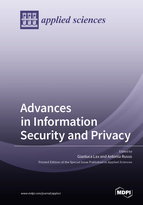Advances in Information Security and Privacy
A special issue of Applied Sciences (ISSN 2076-3417). This special issue belongs to the section "Electrical, Electronics and Communications Engineering".
Deadline for manuscript submissions: closed (15 October 2021) | Viewed by 49264
Special Issue Editors
Interests: privacy; access control; blockchain; social network analysis
Special Issues, Collections and Topics in MDPI journals
Interests: security; privacy; access control; social network analysis
Special Issues, Collections and Topics in MDPI journals
Special Issue Information
Dear Colleagues,
With the recent pandemic emergency, many people are spending their days at home and have increased their use of digital resources for both work and entertainment. The result is that the amount of digital information handled online is dramatically increased, and we can observe a significant increase in the number of attacks, breaches, and hacks. This Special Issue aims at establishing the state of the art in protecting information by mitigating information risks. Works related to reducing the probability of disclosure, unauthorized access, deletion, corruption, and devaluation of information are welcome. There will be particular interest in works whereby security is achieved using techniques from cryptography and machine learning. This Special Issue also welcomes survey papers that give the reader an overview of the state of the art in these topics.
Prof. Gianluca Lax
Dr. Antonia Russo
Guest Editors
Manuscript Submission Information
Manuscripts should be submitted online at www.mdpi.com by registering and logging in to this website. Once you are registered, click here to go to the submission form. Manuscripts can be submitted until the deadline. All submissions that pass pre-check are peer-reviewed. Accepted papers will be published continuously in the journal (as soon as accepted) and will be listed together on the special issue website. Research articles, review articles as well as short communications are invited. For planned papers, a title and short abstract (about 100 words) can be sent to the Editorial Office for announcement on this website.
Submitted manuscripts should not have been published previously, nor be under consideration for publication elsewhere (except conference proceedings papers). All manuscripts are thoroughly refereed through a single-blind peer-review process. A guide for authors and other relevant information for submission of manuscripts is available on the Instructions for Authors page. Applied Sciences is an international peer-reviewed open access semimonthly journal published by MDPI.
Please visit the Instructions for Authors page before submitting a manuscript. The Article Processing Charge (APC) for publication in this open access journal is 2400 CHF (Swiss Francs). Submitted papers should be well formatted and use good English. Authors may use MDPI's English editing service prior to publication or during author revisions.
Keywords
- Confidentiality
- Integrity
- Availability
- Non-repudiation
- Access control
- Identification
- Authentication
- Authorization
- Risk management







